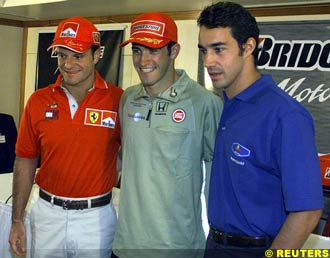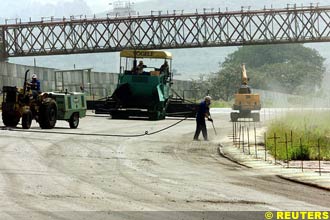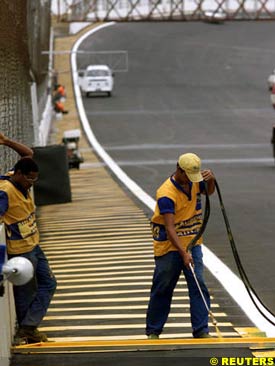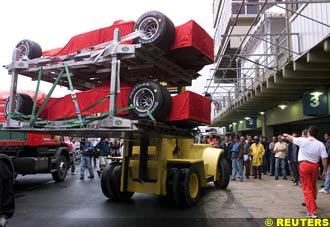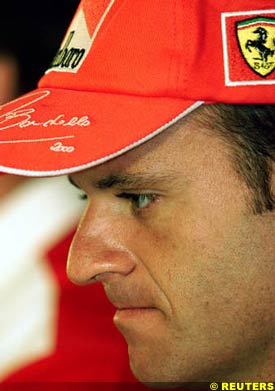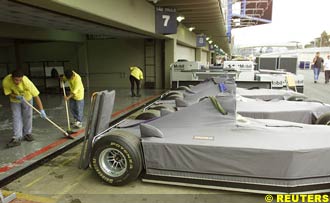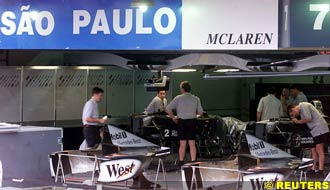 |
The Brazilian GP Preview |
| Interlagos, Sao Paulo | by Ewan Tytler, U.S.A. |
|
Leaving Albert Park in Melbourne, Formula One moves to another lakeside circuit - Interlagos in Sao Paulo, Brazil. The Autodromo Jose Carlos Pace is named after the great Brazilian Formula One driver who scored his only Grand Prix victory on this circuit in 1975 but, tragically, was killed in a plane crash on the 18th of March 1977.
Sao Paulo is very close to the Tropic of Capricorn. In the dry, Interlagos tends to be hot, humid and dusty. Rain in Sao Paulo is always a possibility, the start of the 1996 race was a wash-out. Fortunately, the surface of Interlagos dries quickly. Altitude also affects the set-up, Gary Anderson of Jaguar explains: "In Brazil you run a high downforce setting on the car but because of the high altitude you lose about 10 per cent of the downforce".
In its current form, Interlagos is the third shortest Grand Prix circuit and is one of the slowest, comparable with Magny Cours. This was not always so. In 1990, the circuit length was shortened from 7.874 to 4.325 Km (4.893 to 2.687 miles). In 1997 further modifications to the track at the pit exit reduced the lap distance to its current 4.292 Km (2.667 miles).
Interlagos presents a real test of driving skill, with many changes in elevation and several challenging corners. There are only two passing opportunities; at Senna's S at the end of the pit straight and Descida do Lago, at the end of the Reta Oposta.
Interlagos is one of the bumpiest circuits in the calendar, despite regular resurfacing. It has just been resurfaced again in February. The circuit is extremely hard on both man and machine with cramps and driver fatigue becoming major problems. Interlagos is unusual because, like Imola and Kyalami, it is run in an anti-clockwise direction, hence the majority (10 out of 15) of corners are left-handers. McLaren's David Coulthard explains: "Because drivers regularly race and test on clockwise tracks this can cause some discomfort on the left hand side of the neck which isn't as used to experiencing g-force loads as the right side." Despite these drawbacks, many drivers thoroughly enjoy Interlagos.
Benetton's Technical Director, Pat Symonds added, "Downforce levels are medium to high and the suspension settings are optimised around ride, due to the bumps, and ensuring good traction particularly out of the slow final corner. Interlagos is a circuit that presents no problems for the brakes." Ralf continued: "From the drivers' point of view, Interlagos is a real challenge for the wide variety of corners, ranging from the quick left handers at the end of both straights to a twisty infield where establishing good rhythm is vital. The best place for overtaking is at the end of the long start/finish straight."
Ferrari's Rubens Barrichello adds that, "Brazil will be a complete contrast to the first race. The track is a lot quicker and the high speed corners are much more demanding physically, especially on the neck. In particular, it's a track where you can overtake more easily than Melbourne."
Pits Stops and Tyre Strategy
The surface of Interlagos is quite abrasive and the tyres will wear more quickly than in Melbourne. Bridgestone's technical manager, Yoshihiko Ichikawa, explains: "We'll be taking two specifications of dry tyres to Interlagos - Medium and Soft, which is the same specification as those used in Australia - even though the track surfaces at these two circuits are completely different. At Interlagos the softer dry tyre is prone to increased degradation of grip. If the teams choose the Soft specification they also have to consider the increased tyre wear and this factor will figure strongly in the race strategies. I anticipate the teams running a two-stop strategy. Interlagos, like Barcelona and Silverstone, is one of the few circuits that causes significant degradation in the tyres. In Melbourne, the teams were using scrubbed or old tyres during both qualifying and the race to reduce understeer.
Right-hand tyres also tend to wear out more quickly than the left-hand ones due to the anti-clockwise direction of the track. Benetton's Pat Symonds says that, "It is likely that most teams will be striving to make the softer tyre work in spite of the fact that this is traditionally a one-stop race. The strategy employed for this race is not just dictated by the normal factors of tyre degradation and the effect of fuel mass, but also by the fact that Interlagos has the longest pit lane of the Formula One circuits and the new lower speed limits will push strategies even more in the direction of one stop."
In last year's race the first three finishers were on a one-stop strategy and in 1998, McLaren took a one-two victory on a one-stop strategy. Most teams adopted a one-stop strategy at Melbourne, so it would be no surprise if last year's pit-stop strategies were repeated on Sunday. Attrition has been variable at Interlagos, ranging from 18 finishers in 1997 to only 9 last year. Gearbox failures are the most common mechanical problems. At the end of the 1995, 1996 and 1999 races only two cars were on the lead lap. This year's event promises to be more exciting with the front running cars being a lot closer.
The Teams
Michael Schumacher is the most successful and consistent driver at Interlagos, having finished in the points in every single Brazilian Grand Prix that he has entered. 1997 was the only year in which he did not have a podium finish. Schumacher has never set pole position at Interlagos, but he has qualified second in 1994, 1995 and 1997. "Sure it was great to win the opening race in Australia, but I missed the opportunity of showing the world that I could have beaten the McLarens even if they had not dropped out of the race with engine problems," Schumacher recently commented. "This year's Ferrari feels a lot better than last year's and it should be competitive on all types of tracks, even over the bumps and long high speed corners that we have in Interlagos."
Rubens Barrichello is second in the World Drivers' Championship, after setting his career-first fastest lap at Albert Park. For Barrichello this is truly be a home Grand Prix as he was born in Sao Paulo.
Barrichello has only finished the Brazilian Grand Prix once - 4th for Jordan in 1994. Barrichello led for 25 laps of last year's race in a Stewart-Ford and he has qualified well, taking second position on the grid in 1996 and third in 1999. Barrichello now has an excellent chance of a podium finish, perhaps even a win, with the fast and reliable Ferrari F1-2000. "It will be a big motivation racing in front of my home crowd," said Barrichello. "It has always been my dream since I watched races here as a boy to drive for Ferrari and now I will be doing it in a car that is capable of winning the race. If I was to win my first race in Brazil it would be too much for words."
BMW's Technical Director, Dr. Werner Laurenz, added: "Although we may not repeat the good result we achieved in Australia, our aim is to get both cars to see the chequered flag in Sao Paulo." Williams cars have seen the chequered flag at Interlagos many times, winning three times and finishing in the points in all races at the modern Interlagos, with a total of 64 points. Williams holds the qualifying record for Interlagos set by Nigel Mansell in 1992. Williams have the advantage of testing the FW22-BMW at Kyalami, another high-altitude, anti-clockwise circuit.
Ralf Schumacher is third in the World Drivers' Championship. Ralf finished 4th in last year's race and his highest grid position was 8th in 1998. "After our good start in Melbourne, I am looking forward to racing at Interlagos," said Ralf. "In 1997, I started from 9th position. Unfortunately, I had an electronic failure during the race that resulted in retirement on lap 53 when I was in 12th place. In 1998, I span off into Descide do Lago but last year we finished fourth."
Jenson Button made an impressive Formula One debut at Melbourne but he may find that Interlagos is a greater challenge than Albert Park. Button confessed, "It's obviously difficult to get a true impression (of Interlagos) from the on-board footage I've been studying and the team is helping to develop my understanding further with data from last year. I have raced karts on anti-clockwise circuits, but never a Formula One car, apart from our recent test at Kyalami that was plagued by horrendous weather conditions. I learned a great deal from Melbourne and I can't wait to go racing again."
British American Racing (BAR) are second equal in the constructors' championship. Neither BAR finished last year's race. Like Williams, BAR also have the advantage of testing the BAR 002 at Kyalami. Chief Engineer, Steve Farrell said: "We will be playing the 'reliability card' again in Brazil, aiming to capitalise on the probable misfortunes of others."
Ricardo Zonta was born in Curitiba, Paraná, which is about 200 miles SW of Sao Paulo. Zonta knows Interlagos quite well, having driven there in Formula 3. In the practice for last year's race he broke a bone in his foot which put him out of contention for four Grands Prix. Ricardo Zonta's Race Engineer, David Lloyd stated that, "As far as Ricardo is concerned, we're going to concentrate on qualifying and getting the most out of our tyres in Brazil. We'll do some back-to-back runs on new and scrubbed rubber just to confirm our thinking and make sure he's confident with his car. Interlagos isn't particularly a power circuit, so we're going to aim for reliability and getting a higher grid position for Ricardo in qualifying. If we then get our race strategy right, he should be there at the chequered flag to claim some more points."
Benetton is now fourth in the constructor's championship. Benetton is the hot topic in the pitlane as they are being taken over by Renault, however this takeover should not affect their preparation for Brazil. Pat Symonds stated, "In the case of the Benetton team, modifications for this race are centred around fixing small problems that occurred during the Australian Grand Prix weekend. There are no new performance parts on the car for this race."
Benetton have been a consistent team at Interlagos, finishing in the points in every Brazilian Grand Prix from 1990-1998 with a total of 38 points.
McLaren have once again started the season as competitive but unreliable. Mercedes Motor Sport Director, Norbert Haug explains that, "The same problem on the engine's pneumatic valve system, which caused failures during free practice in Australia, stopped us during the race. We have to fix that rapidly in order not only to be quick but to finish races."
McLaren have won the Brazilian Grand Prix four times at the modern Interlagos and have finished in the points in the last 5 Brazilian Grand Prix with a total of 70 points.
Mika Hakkinen must be a favourite to win this race. He won the last two races, winning for pole position and setting fastest lap and he finished 4th in 1995, 1996 and 1997. Hakkinen's competition will be stiffer this year but if he can win, this could set him on the road to a third championship. Hakkinen stated, "The whole team is optimistic that we will leave Brazil with a good result and I'm focusing on scoring my first points of the season, and my third consecutive Brazilian Grand Prix victory."
David Coulthard finished 2nd in his Brazilian Grand Prix debut in 1995 for Williams and again in 1998 for McLaren. His highest grid position was second in 1998 and 1999. If Coulthard wants to be the 2000 World Champion, he must find a way to win at Interlagos. A win could change the balance of power within McLaren and also plant seeds of doubt in Hakkinen's mind. Coulthard commented, "We are all looking forward to the Brazilian Grand Prix. However it will be tough, as Interlagos is one of the most physically-demanding circuits on the calendar for drivers. I have finished second here in 1995 and 1998 and I plan to go one better in 2000."
Heinz-Harald Frentzen finished third in last year's race for Jordan and 5th in 1998 for Williams. His highest grid position was third, also in 1998. Frentzen commented, "The season will start for Jordan in Brazil. Australia was very disappointing for us and I am looking forward to putting things right at Interlagos. I enjoy the circuit and we have seen some good races there in the past with good overtaking manoeuvres. Last year was good for us in Brazil and it would be great to repeat that performance."
Jarno Trulli has yet to score a point at Interlagos, his only finish was 12th in 1997 for Minardi while his highest grid position was 12th in 1998 for Prost. Trulli remains optimistic none the less, saying: "I think I showed in Melbourne that I am able to do a good job. The pressure is certainly on me and on the team, but I trust in myself and I am very motivated, which makes things easier for me and I do not think I will have any problems during the season as far as coping with the pressure goes. This is my best chance to get close to the top two teams."
Jaguar had a disastrous start to the 2000 season, completing very few race laps at Melbourne. Jaguar's Technical director, Gary Anderson gave a vague explanation, saying that "We feel we've identified the main problem. What happened in Melbourne was something new that stepped in on us, we shot ourselves in the foot really. We ran at Silverstone for two days and we didn't really get the program done that we wanted to, because we were still trying to get on top of systems things and trying different engine solutions. It's not an easy one, it's an integrated engine thing, but Cosworth are working on it at the moment and doing some modifications." Jaguar's previous incarnation, Stewart-Ford, had a terrible record at Interlagos with only one finish provided by Jan Magnusson in 1998.
Johnny Herbert is the only active Grand Prix driver to have competed in the Brazilian Grands Prix at Interlagos and at Rio de Janeiro's Jacarepagua circuit. In his first Grand Prix, Herbert finished 4th at Jacarepagua in 1989 for Benetton. Herbert also finished 4th at Interlagos in 1993 for Lotus and his highest qualification was also 4th in 1995 for Benetton. The ebullient Herbert is hoping for a change in fortune, saying: "Things can only get better from now. I'll be going to Brazil with a clean sheet so I can start the 2000 season over again. I enjoy racing at Interlagos, as the atmosphere is incredible. The noise generated by the crowd can be enormous, and after Rubens Barrichello's performance in Australia they will be out in force this year."
Eddie Irvine has scored two points at Interlagos, finishing 5th in last year's race. Irvine lacks speed at Interlagos, his highest qualification was 6th in 1998 and in 1999 with Ferrari. "This year, we have to be realistic about our chances," Irvine mused. "My qualifying performance in Australia showed the Jaguar R1 has a good turn of speed, but still needs to improve in terms of reliability. The Interlagos circuit doles out a serious mechanical beating and will provide us with a stern test of how much progress we have made."
Sauber made a strong showing at Melbourne. However, the Swiss team scored only one point at Interlagos with Karl Wendlinger's 6th place finish in 1994.
Mika Salo was desperately unlucky to leave Albert Park empty-handed after giving the most spirited drive of the Grand Prix. Team Principal, Peter Sauber, explained: "The problem was caused because the C19 is still fitted with the old C18 front wing and nobody at the factory ever measured its dimensions." Salo has been a consistent finisher at Interlagos, his best result was 5th in 1996 for Tyrrell. Salo's highest grid position was 11th, also in 1996. Salo commented, "I am determined to put the disappointment of Melbourne behind me, and to do even better in Brazil. On a circuit I really like and with a car that feels very good, I will be looking for another strong performance."
Sao Paulo's Pedro Diniz has yet to score a point in Formula One at Brazil. Diniz' best Formula One finish was 8th in 1996 for Ligier while his highest grid position was 15th in 1999 with Sauber. Diniz' best result at Interlagos was a 2nd place in a Formula 3 race in 1990. "It is very exciting to race in my home-town despite the extra pressure on us Brazilian drivers," Diniz stated. "The track has changed from last year, so I hope they have solved the problems with the bumps. I love the challenge of the Interlagos circuit. I am sure, from the lap times I recorded in Melbourne, that Sauber can do well and I can perform better than in Melbourne."
Prost, despite its pre-season woes, managed to get a car to finish at Melbourne which, in itself, was a major achievement. Prost is not out-of-the-woods yet, Peugeot's sporting director, John Walton reveals that "It's clear we have still a lot of work ahead of us, especially on the electronic system in order to improve the car's reliability. We have progressed a little in performance but we have not been able to advance as we wished, because of the problems encountered in other areas." Prost scored five point at Interlagos with Olivier Panis finishing 3rd in 1997 and 6th in 1999. Team Principal, Alain Prost won the Brazilian Grand Prix a record 6 times including once at Interlagos in 1990.
Jean Alesi is the only driver to have competed in every Grand Prix at the modern Interlagos. Alesi finished in the points in 6 of these 10 races, with a total of 17 points. Alesi's best finish was second in 1996 for Benetton and his highest grid position was 3rd in 1994 with Ferrari. Alain Prost commented, "He continued to use all his experience in the work of developing and improving the car. He kept a very serene and determined approach to the job and for the challenge this weekend."
Nick Heidfeld qualified 15th at Melbourne, ahead of his teammate Alesi, and was the only novice to finish his first Grand Prix at Albert Park. Alain Prost commented, "Nick handled himself exactly as one expected. He did not know the circuit, but very quickly showed he could adapt himself to it. It was very important for the team that he managed the race so well and conformed to the team's technical instructions. Now, having put the anxiety of the first race behind him, he can concentrate more freely on his performance and I have no worries about his ability to adapt to the Interlagos circuit."
Arrows have moved from the back of the grid into the midfield. As for their new colour scheme, what can I say? Hallowe'en II? Their performance at Melbourne was both promising and disappointing. "The intense heat at the (Melbourne) circuit, together with increased brake temperatures, had caused the carbon-fibre bond on the steering-arms to break down," a team official revealed. Redesigned steering-arms will be fitted to the Arrows A20's for Interlagos. Arrows, as Footwork, scored one point at Interlagos when Michele Alboreto finish 6th in 1992.
Jos Verstappen's only finish at Interlagos was 15th in 1997 for Tyrrell. His highest grid position was 9th in 1994 with Benetton. Verstappen commented: "Obviously I am looking forward to going to Sao Paulo. We have a couple of weeks to sort out some minor problems on the car and I think Brazil is where we can show our pace. I prefer this sort of circuit rather than street circuits. I am really looking forward to it and I think our car can perform well. I think there will be a lot of spectators there, especially since Rubens did well in Australia and I think that can only be good for all of us."
Pedro de la Rosa qualified 18th and did not finish last year's race. De la Rosa stated, "I would like to be in Brazil now after this race because we are really looking very good. We have learned several important lessons in Melbourne and we should be more competitive in Brazil. I think the car is quick but I don't know how it will adapt to the Sao Paulo circuit because it is always bumpy."
Minardi have started the season by closing the gap to the front runners with Marc Gene finishing 8th at Melbourne. In fact, the 107% qualifying rule was never an issue at Melbourne. Minardi have yet to score a point at Interlagos. In last year's race, Gene qualified 20th and finished 9th. Argentinian newcomer Gaston Mazzacane qualified last at Albert Park and did not finish his first Grand Prix.
My Predictions
If it is dry, I'm going to pick McLaren, Ferrari and Jaguar as the top three teams.
Starting grid:
|
||||
|
The Brazilian Grand Prix Preview in a Nutshell:
|
Everything you Need to Know about Interlagos
The Atlas F1 1999 Brazilian GP Preview Issue
The Atlas F1 1999 Brazilian GP Review Issue |
|||
| Ewan Tytler | © 2000 Kaizar.Com, Incorporated. |
| Send comments to: tytler@atlasf1.com | Terms & Conditions |
Images provided by Reuters | |
